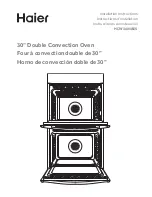
14
15
KMW1698
• Clean the oven door and sealing surface.
• Reorient the receiving radio or television aerial.
• Relocate the microwave oven compared to the receiver.
• Move the microwave oven away from the receiver.
• Plug the microwave oven into a different power outlet so that the
microwave oven and receiver are on different circuits.
2.1. Product Description
PART NAMES
1. Door Safety Lock System
2. Oven Window
3. Roller Ring
4. Control Panel
5. Wave Guide (Please do not
remove the mica plate
covering the wave guide)
6. Glass Tray
7. Door Release Button
CONTROL PANEL
The control panel has two controls. One is a
timer control, and another a power control.
POWER/ACTION SELECTOR
Use this control to select the cooking power
level. It is the first step before cooking.
TIME CONTROL
It shows the timer settings. Turn the control to
select the cooking time of up to 30 minutes.
MICROWAVE COOKING
For pure microwave cooking, there are six
power levels from which to choose.
The power level increases as the control is
turned clockwise. The power levels can be
classified as follows:
Power Output
Description
1
100%
HIGH
2
85%
M. HIGH
3
66%
MED
4
48%
M. LOW
5
40%
DEFROST
6
17%
LOW
2.2. Operating Instructions
MICROWAVE COOKING PRINCIPLES
• Arrange food carefully. Place the thickest areas towards the outside
of the dish.
• Monitor cooking times. Cook for the shortest amount of time
indicated and add more as needed. Severely overcooked food can
smoke or catch fire.
• Cover foods while cooking. Covers prevent spattering and help
foods to cook evenly.
• Turn foods over once during microwave cooking to speed up the
cooking of such foods as chicken and hamburgers. Large items like
roasts must be turned over at least once.
• Rearrange foods such as meatballs halfway through cooking both
from top to bottom and from the center of the dish to the outside.
UTENSILS GUIDE
• The ideal material for a microwave utensil is transparent to
microwaves, it allows energy to pass through the container and
heat the food.
• Microwaves cannot penetrate metal, so metal utensils or dishes
with metallic trim should not be used.
• Do not use recycled paper products when microwave cooking, as
they may contain small metal fragments which may cause sparks
and/or fires.
• Round /oval dishes rather than square/oblong dishes are
recommended as food in corners tends to overcook.
• Narrow strips of aluminum foil may be used to prevent the
overcooking of exposed areas. But care should be taken not to use
too much and a distance of 1 inch (2.54cm) kept between the foil
and the cavity.
• The list below is a general guide to help you select the correct
utensils.
COOKWARE
MICROWAVE
Heat–Resistant Glass
Yes
Non Heat–Resistant Glass
No
Heat–Resistant Ceramics
Yes
Microwave–Safe Plastic Dish
Yes
Kitchen Paper
Yes
Metal Tray
No
Metal Rack
No
Aluminum Foil & Foil Containers No
1
2
4
5
6
7
3
EN
microwave oven









































